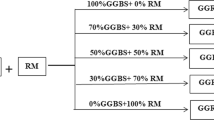Abstract
Green building materials have attracted attention recently due to sustainability issues. Agricultural waste used as alternative raw materials in the manufacturing of building products, fired clay bricks in particular, is an innovative way of waste utilisation. Large quantities of waste are produced in grain processing. New ways of utilising this waste are required for solving this problem. The main objective of this study is to investigate the effects of agricultural solid waste (oat husk and barley husk and middlings) on the physical and mechanical properties and porosity of fired clay bricks. Brick moulding compounds were prepared by adding 5%, 10% and 20% of oat husk or barley husk and middlings and fired at 900 °C and 1000 °C temperature, keeping them at the highest temperature for 1 h. Oat husk, barley husk and middlings incinerate at 500 °C temperature, thus forming a porous structure in the clay body. The addition of 5–10% of oat husk or barley husk and middlings into brick moulding compound produces eco-friendly fired clay brick having the density of 1300–1800 kg/m3, compressive strength of 3.3–9.5 MPa, total open porosity of 34–49%, water absorption 14–28%. Oat husk or barley husk and middlings reduce the compressive strength of eco-friendly fired clay brick.
Similar content being viewed by others
References
P. Muñoz Velasco, M.P. Morales Ortíz M.A. Mendívil Giró, L. Muñoz Velasco, Fired clay bricks manufactured by adding wastes as sustainable construction material — a review, Constr. Build. Mater. 63 (2014) 97–107.
C.C. Bories, M.E. Borredon, E. Vedrenne, G. Vilarem, Development of eco-friendly porous fired clay bricks using pore-forming agents: a review, J. Environ. Manag. 143 (2014) 186–196.
M. Sutcu, S. Ozturk, E. Yalamac, O. Gencel, Effect of olive mill waste addition on the properties of porous fired clay bricks using Taguchi method, J. Environ. Manag. 181 (2016) 185–192.
I. Demir, An investigation on the production of construction brick with processed waste tea, Build. Environ. 41 (9) (2006) 1274–1278.
G. Gorhan, O. Simsek, Porous clay bricks manufactured with rice husks, Constr. Build. Mater. 40 (2013) 390–396.
J. Sutas, A. Mana, L. Pitak, Effect of rice husk and rice husk ash to properties of bricks, Proc. Eng. 32 (2012) 1061–1067.
G.W. Carter, A.M. Cannor, D.S. Mansell, Properties of bricks incorporating unground rice husks, Build. Environ. 17 (4) (1982) 285–291.
R. Chandra, H. Takeuchi, T. Hasegawa, Methane production from lignocellulosic agricultural crop wastes: a review in context to second generation of biofuel production, Renew. Sustain. Energy Rev. 16 (3) (2012) 1462–1476 (review).
N. Sarkar, S. Kumar Ghosh, S. Bannerjee, K. Aikat, Bioethanol production from agricultural wastes: an overview, Renew. Energy 37 (1) (2012) 19–27.
M.A. Rahman, Properties of clay-sand-rice husk ash mixed bricks, Int. J. Cem. Compos. Lightw. Concr. 9 (2) (1987) 105–108.
M.A. Rahman, Effect of rice husk ash on the properties of bricks made from fired lateritic soil–clay mix, Mater. Struct. 21 (3) (1988) 222–227.
D. Tonnayopas, P. Tekasakul, S. Jaritgnam, Effects of rice husk ash on characteristics of lightweight clay brick, in: Technology and Innovation for Sustainable Development Conference (TISD2008), 2008, 36–39.
K.C.P. Faria, R.F. Gurgel, J.N.F. Holanda, Recycling of sugarcane bagasse ash waste in the production of clay bricks, J. Environ. Manag. 101 (30) (2012) 7–12.
S.R. Teixeira, A. Eunice De Souza, G. Tadeu De Almeida Santos, A.F. Vilche Peña, A.G. Miguel, Sugarcane bagasse ash as a potential quartz replacement in red ceramic, J. Am. Ceram. Soc. 91 (6) (2008) 1883–1887.
A.E. Souza, S.R. Teixeira, G.T.A. Santos, F.B. Costa, E. Longo, Reuse of sugarcane bagasse ash (SCBA) to produce ceramic materials, J. Environ. Manag. 92 (10) (2011) 2774–2780.
L. Barbieri, F. Andreola, I. Lancellotti, R. Taurino, Management of agricultural biomass wastes: preliminary study on characterization and valorisation in clay matrix bricks, Waste Manage. 33 (2013) 2307–2315.
R. Mačiulaitis, Frost Resistance and Durability of Ceramic Facade Products, Technical, Vilnius, 1996. p. 132.
J.F. Peters, Determination of undrained shear strength of low plasticity clays, Int. J. Rock Mech. Mining Sci. Geomech. Abstr. 1 (1991) 13.
H.H. Murray, Overview: clay mineral applications, Appl. Clay Sci. 5 (5–6) (1991) 379–395.
R.W. Welch, M.V. Hayward, D.I.H. Jones, The composition of oat husk and its variation due to genetic and other factors, J. Sci. Food Agric. 34 (1983) 417–426.
A.K. Bledzki, A.A. Mamun, J. Volk, Barley husk and coconut shell reinforced polypropylene composites: the effect of fibre physical, chemical and surface properties, Compos. Sci. Technol. 70 (5) (2010) 840–846.
A. Höije, M. Gröndahl, K. Tømmeraas, P. Gatenholm, Isolation and characterization of physicochemical and material properties of arabinoxylans from barley husks, Carbohydr. Polym. 61 (3) (2005) 266–275.
R. Mačiulaitis, Frost resistance and long service life of ceramic facade products Brick Tile Ind. Int. 5 (1994) 313–322.
N. Phonphuak, Effects of additive on the physical and thermal conductivity of fired clay brick, J. Chem. Sci. Technol. 2 (2) (2013) 95–99.
N.S. Raut, P. Biswas, T.K. Bhattacharya, K. Das, Effect of bauxite addition on densification and mullitization behaviour of West Bengal clay, Bull. Mater. Sci. 31 (7) (2008) 995–999.
F.A.C. Milheiro, M.N. Freire, A.G.P. Silva, J.N.F. Holanda, Densification behaviour of a red firing Brazilian kaolinitic clay, Ceram. Int. 31 (2005) 757–763.
V. Loryuenyong, T. Panyachai, K. Kaewsimork, C. Siritai, Effects of recycled glass substitution on the physical and mechanical properties of clay bricks, Waste Manag. 29 (2009) 2717–2721.
V. Valanciene, R. Siauciunas, J. Baltusnikaite, The influence of mineralogical composition on the colour of clay body, J. Ceram. Soc. 30 (7) (2010) 1609–1617.
R. Kreimeyer, Some Notes on the firing colour of clay brinks, Appl. Clay Sci. 2 (2) (1987) 175–183.
Author information
Authors and Affiliations
Corresponding author
Rights and permissions
About this article
Cite this article
Kizinievič, O., Kizinievič, V., Pundiene, I. et al. Eco-friendly fired clay brick manufactured with agricultural solid waste. Archiv.Civ.Mech.Eng 18, 1156–1165 (2018). https://doi.org/10.1016/j.acme.2018.03.003
Received:
Accepted:
Published:
Issue Date:
DOI: https://doi.org/10.1016/j.acme.2018.03.003




